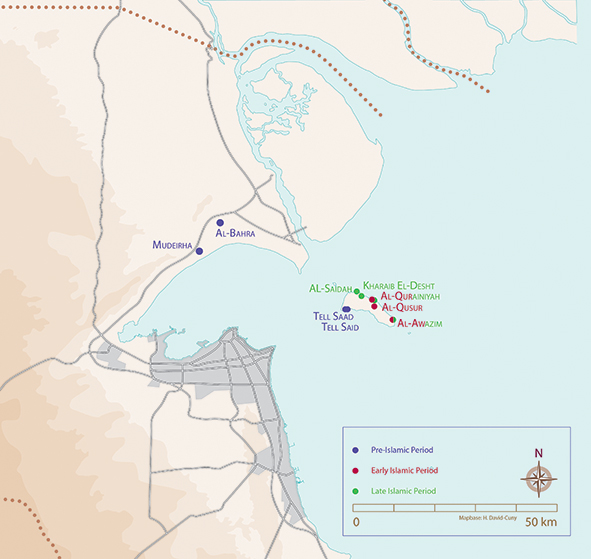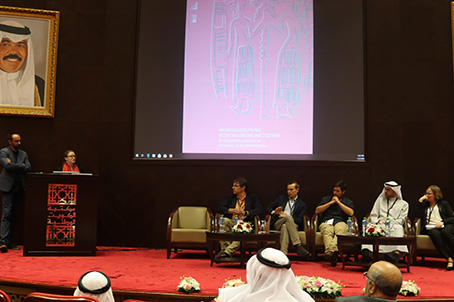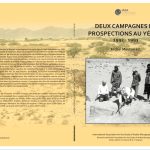From the Neolithic to the late Islamic period : archaeological activities in Kuwait in 2019
- admcef22
- January 30, 2023
CEFAS and IFPO
As a land of history, Kuwait has been exploring its heritage since 1958. If the most ancient settlements, such as Neolithic Bahra 1, Dilmunic Failaka, Hellenistic Fortress or early Islamic al-Qusur, are still under study, new sites have also been discovered. In the last decade, new attention has been given to the exploration of the mainland on the one hand, and to the late Islamic sites on the other. In Kuwait, the archaeological activities are supervised by the National Council for Culture, Arts & Letters (NCCAL), via its Department of Antiquities & Museums (DAMK). Excavations are often undertaken in collaboration with international academic institutions. The year 2019 was particularly rich regarding fieldworks, publications and scientific events.
– Excavations
In 2019, eight archaeological missions took place in Kuwait which involved working on the field or on publications. Seven sites were dug on the mainland and on Failaka island. Two other sites (Tell Sa’ad and Tell Said) were not excavated but were studied for publication. The settlements excavated in 2019 were related to Neolithic, Bronze Age, early Islamic and late Islamic periods (fig. 1).

– Pre Islamic periods
In Kuwait, five teams are currently working on pre-Islamic sites, three on the mainland and two on Failaka island. Two teams are excavating at al-Bahra (Sabiyah region). The Kuwaiti-Polish Archaeological Mission is carrying out its excavations at Bahra 1, a Neolithic settlement occupied at the end of the 6th millennium BC. The 2019 campaign was dedicated to test trenches and excavations of a courtyard. Still at al-Bahra, the Kuwaiti-Georgian Archaeological Mission is now focused on Bronze Age tombsafter completing the excavation of a cult complex in 2017. Few kilometers from this site, there is the Kuwaiti-Swiss Archaeological Mission Project : small-scale monuments in Mashashash – Mudeirah – Eghai conducted its second campaign of survey and excavation of Late Bronze Age tombs in Mudeirah area.

During the Bronze Age period, Failaka Island was linked to the Dilmun civilization. Many sites were excavated by Danish and French Missions, as well as a Slovak-Kuwaiti Mission. No excavations on these sites were undertaken in 2019. The Kuwaiti-Danish Archaeological Mission in Failaka focused during its campaign on the publication of the work carried out on the Bronze Age site at Tell Sa‘ad (Tell F3), west of the south coast of Failaka, from 2012 to 2017, and on the publication about the beads of the same period discovered at Tell F3 and F6 from 1958 to 1963. The French-Kuwait Archaeological Mission in Failaka is also dedicated to the study of the Hellenistic fortress of Tell Said but during the campaign 2019, the team focused on publication of previous campaigns (2011 2018). The Mission also worked on the catalogue of the National Museum Achemenid and Hellenistic terracotta figurines (Bergès 2020).
– Early Islamic period
Excavations on the early Islamic sites increased during the last decade, in particular on Failaka Island. The main settlement of this period is currently considered to be al-Qusur, located in the centre of the island and organized around two churches. The French-Kuwaiti Archaeological Mission in Failaka evidenced that at least its central part was a monastery. In 2019, the team worked on the final publication of 2011-2018 campaigns, but also began the second phase of its program on the field (Bonnéric forthcoming). The boundaries of the esplanade surrounding the churches were better defined and the excavation of three buildings north and south of the monumental church began. One of them is linked to the oldest phase of occupation, probably contemporaneous to the foundation of the monastery (fig. 3). What is probably the second burial area of the site was discovered. Excavations of an area located north to the central part of al-Qusur are carried out by the Kuwaiti-Slovak Archaeological Mission. The team continued the excavation of a courtyard building (building 28) and discovered a large quantity of semi-precious stones, in particular amethyst, leading them to see in this building a jewelry workshop. At al-Qurainiyah, located north of al-Qusur on Failaka coast, the Kuwaiti-Italian Archaeological Mission focused on levels dating from the 2nd century BC to the early Islamic period (Di Miceli 2020). Prior to the work of this team, the site was known for its late Islamic occupation that was also excavated. The study of the artifacts uncovered during the previous campaigns has continued and will be the subject of the second volume of the final publication.

Late Islamic period
For the last 10 years, the DAMK began to explore the modern heritage of Kuwait. In Failaka, three teams are currently excavating late Islamic settlements gathered on the northern coast of the island. In the village of al-Saidah, on the northwest coast of Failaka, east of the bay of al-Khidr, the Gulf Cooperation Council Team partially excavated the Tell 17, where a 504 m² building was discovered. East to the bay, the Kuwaiti-Polish Archaeological Mission identified a large mosque at Kharaib al-Dasht (17th-19th centuries). It is composed of two elongated rooms and preceded by a courtyard (fig. 4). The northern wall of the prayer room shows a semicircular mihrab. In addition, the team continued the survey and mapping of the underwater archaeological structures of Failaka, concentrating in 2019 on the south-east coast of the island where stone fish traps linked to late Islamic settlements were discovered. The Kuwaiti-Georgian Archaeological Mission carried out surveys in the north-eastern part of the island. In 2019, the team focused on installations probably related to water collection dating from the modern period (17th-first half of the 20th century).

Dissemination of the research
In 2019, the CEFAS and the NCCAL organized an international seminar and published a monographic study and the proceedings of a conference. Some articles were also published by scholars about Kuwaiti archaeology.
International Seminar
The 4th International Seminar on the Archaeology of the Arabian Peninsula entitled Archaeological Failaka : Recent & Ongoing Investigations was held from November 26 to 28, 2019. It was organized by the NCCAL and the French Centre for Archaeology and Social Sciences (CEFAS) and coordinated by S. Al Duwish, H. Al Mutairi, F. Al Sabah from the NCCAL, as well as J. Bonnéric and R. Crassard from the CEFAS. This international symposium brought together all the teams working on Failaka in order to present an overview of the work carried out on this island of historical prime importance (fig. 6). The first two days were devoted to lectures at the National Library, in particular with focuses on pottery study and geology. The third day consisted of workshops between members of the missions, in the laboratories or in the field at Failaka. The discussions were fruitful and could lead to different collaborations between these teams. Proceedings will be published in 2021 in a special issue of Arabian Archaeology & Epigraphy.

Publications
Two fundamental works for the archaeology of Kuwait were published in 2019 :
G. Grassigli & A. Di Miceli (eds.), Al Qurainiyah, Failaka. Kuwaiti-Italian Excavations 2010-2015. Volume 1 Stratigraphy and Phases, Kuwait, 2018.
M. Ruttkay, B. Kovár, K. Pieta (eds.), Archaeology of Failaka and Kuwaiti Coast – current research, Nitra, 2019.
The first is a monograph. It is the first part of the final publication of the first program of the Kuwaiti-Italian Archaeological Mission at al-Qurainiyah. A final publication of the archaeological excavations is requested by the NCCAL who is taking in charge color printing without any limits of figures, which is precious in archaeology. The second publication consisted of the proceedings of a conference organized in 2016 in Nitra (Slovakia) by the authors. It provides a very broad overview of the archaeological activities carried out on the island of Failaka, but also on the mainland. It is important to notice that various articles were also published that year, in particular Ashkanani et al 2019, Durand 2019, Højlund & Hagelquist 2019, Mierzejewska 2019a, 2019b.

Acknowledgements
I would like to thank my colleagues for the information, clarifications and illustrations they have provided : Hamed Al-Mutairi (DAMK), Jimsher Chkhvimiani (KGAM), Andrea Di Miceli (KIAM), Flemming Højlund (KDAM), Magdalena Nowakowska and Agnieszka Pieńkowska (KPAM), Tara Steimer (Kuwaiti-Swiss Mission).
– Bibliography
Ashkanani H., Tykot R., Al-Juboury A., Stremtan C., Petřík J., & Slavíček K., “A characterisation study of Ubaid period ceramics from As‐Sabbiya, Kuwait, using a non‐destructive portable X-Ray fluorescence (pXRF) spectrometer and petrographic analyses”, Arabian Archaeology & Epigraphy 30/2 : 3-18.
Bonnéric J., « Actualité de la recherche archéologique au Koweït : année 2019 », Le carnet de la MAFKF. Recherches archéologiques franco-koweïtiennes de l’île de Faïlaka (Koweït), forthcoming.
Bergès E., « Les figurines de terre cuite de Faïlaka : un catalogue en préparation », Le carnet de la MAFKF. Recherches archéologiques franco-koweïtiennes de l’île de Faïlaka (Koweït), 6 May 2020. [On line] https://mafkf.hypotheses.org/2056
Di Miceli A., “Overview of the early Islamic site discovered by the Kuwaiti-Italian Archaeological Mission of al-Qurainiyah”, Le carnet de la MAFKF. Recherches archéologiques franco-koweïtiennes de l’île de Faïlaka (Koweït), 28 April 2020. [On line] https://mafkf.hypotheses.org/2041Durand C., “A glimpse of daily life in a Hellenistic fortress of the Arab-Persian Gulf. A pottery assemblage from Failaka/Ikaros (Kuwait)”, in Peignard-Giros A., Daily Life in a Cosmopolitan World : Pottery & Culture during the Hellenistic Period, Proceedings of the 2nd Conference of IARPotHP, Lyon, November 2015, 5th-8th, IARPotHP 2, Phoibos Verlag, Vienna, 2019 : 573-582.
Grassigli G. & Di Miceli A. (eds.), Al-Qurainiyah, Failaka. Kuwaiti-Italian Excavations 2010-2015. Volume 1 Stratigraphy and Phases, Kuwait, 2018.
Højlund F. & Hagelquist C.P., “A new temple platform at Tell F6 on Failaka Island, Kuwait”, Arabian Archaeology & Epigrahy 30/2, 2019 : 173-178. https://doi.org/10.1111/aae.12149
Mierzejewska M., « Hearths, ovens and fishery : Kharaib al‐Dasht as a case of Late Islamic fishing village (Jazirat Faylaka) », Arabian Archaeology & Epigraphy 30/2, 2019a : 263-279.
Mierzejewska M., “Islamic harbour in Kharaib al-Dasht Bay ? Some remarks on the pottery collection from the Underwater Survey along the coast of Failaka Island”, Pieńkowska A., Szeląg D., & Zych I. (eds.), Stories told around the fountain. Papers offered to Piotr Bieliński on His 70th Bithday, 2019b : 477-492.
Ruttka M., Kovár B. & Pieta K. (eds.), Archaeology of Failaka and Kuwaiti Coast – current research, Nitra, 2019.






